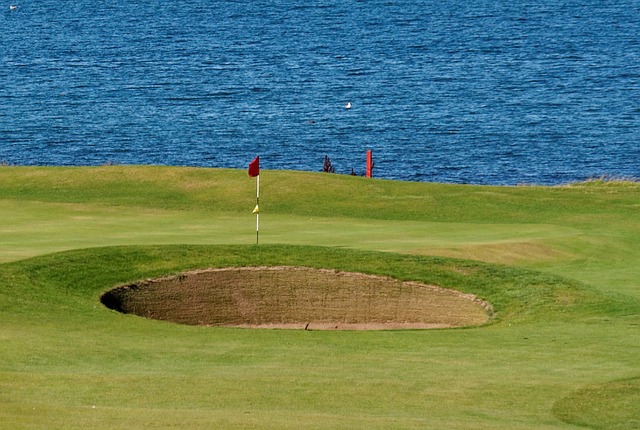The guardians of the rules of golf, the Royal and Ancient, in partnership with the USGA, has announced new rules that could mean golfers will be forced to use specially adapted golf balls.
Under the new rules, golfers will have to use an adapted ball that has been designed not to travel as far as the current balls used by the top players today.
The new ball design is expected to take off around 15-yards from the tee shots of most top players.
The R&A and USGA hope that their plans will be adopted across all forms of elite golf, which suggests all the top tours in addition to the Majors, by 2026.
Why Hitting The Ball Further Is An Issue
So why is the fact that professional players are hitting the ball so much further such a problem for the R&A and for professional tour golf?
And just how big is the problem facing golf’s rule-makers?
Let’s begin by answering the second of those two questions first.
Average Drive Length Increase
Back in the mid 1900s, golfers typically drove the ball just over a couple of hundred yards, while a drive of 250 yards was deemed to be truly eye-opening.
As such, the majority of courses, including many of the ones use in Major Championship rotation, were designed around players being able to hit the ball between 220-250 yards with their tee-shots.
But by 1980, the USPGA leader for average drive distance, Dan Pohl, was averaging 274.3 yards per drive as new technology in golf in terms of the clubs used and the composition of the golf ball, saw those distances increase over the years.
From 1980, through to 1997, there was an explosion in the game of golf as newly designed clubs and balls saw golfers managing to hit the ball further and further.


Daly Hits 300 Yard Average In 1997
By 1997, John Daly had become the first player to average over 300 yards pr drive (302 yards), while the average tour player was hitting drives around 267-268 yards.
Since 1997, there has been just one year when the top average driver of a golf ball has hit it under 300 yards (that was 1998, when John Daly averaged 299.4 yards) and by 2003, Hank Kuehne topped the charts for average drive distance at 321.4 yards.
However, the average drive distance of all players on tour was now at 286 yards and while for the next 15 years or so, the top driving average on tour hovered between 310 and 320 yards, the average distance increase markedly to around 290 yards for the average PGA Tour golfr.
By 2017, that average had increased to almost 293 yards for the average PGA Tour pro and by 2020, when Bryson DeChambeau averaged over 320 yards for the first time as the tour’s longest driver, the average had crept up to 295 and even almost hit 300 yards in 2022, when it averaged at 299.8 yards across the tour.
Last year saw the average drive drop slightly to 297, but Rory McIlroy set a new high mark for the longest average drive on tour of 326.6 yards.
That means since 1980, the top average driver is hitting the ball on average around 50 yards further per drive, while even the average PGA Tour pro is hitting the ball at least 40 yards further.
Running Out Of Real Estate
Now, while these technological advances have helped players hit the ball further and further, the net result of that has seen the art of golf on a great many courses fundamentally changed.
In many cases, now that players can average over 300 yards per drive, and often far further when wind conditions or the lie of the land will help their drive go further, it has meant that so many courses are becoming what Rory McIlroy called “pitch and putt” for professionals.
Over the years, course designers have tried to combat the increase in distance by lengthening holes, adding more obstructions, moving tee boxes back and the like.
The problem with that is that courses have quickly run out of real estate to adapt their courses. Not to mention the fact that this method is hugely expensive if you consider the sheer number of courses that would need to be adapted, if indeed they are able to be altered.
However, even courses that have been lengthened are still not a match for the average tour professional of today.


Key Reasons Why Courses Of Today Are Becoming Ineffective Against Top Professionals
- When the course was originally designed, its bunkers, hazards and similar were designed to test the golfers of the day. On some holes nowadays, it is easy for the top professionals to drive the ball over hazards easily, which renders them ineffectual for the vast majority of players, thus the hole plays a lot easier.
- Holes that were designed as short par fours are often now driveable for many players. The 18th hole at St Andrews is perhaps one of the most famous examples of this, but it is just one of many holes that players can now reach with a tee shot.
- Long par fours have become a drive and a 8 or 9 iron or even a wedge shot, making these tricky holes easier for the bigger hitters.
- Similarly, par fives can, in most cases, be easily reached by players in two shots, rather than the three they were originally designed for.
- Another issue is golf club manufacturers. There is no benefit to them developing new clubs that will hit the ball shorter distances than their last incarnation. Manufacturers are therefore always looking for ways they can design clubs to hit the ball further.
Therefore, for many years, many top golfers have stated that the only sensible way to combat players hitting the ball further, was to change the design of the golf ball to make it fly a shorter distance.
The news has not gone down well with all golfers, with LIV Golf Tour professional Bryson DeChambeau labelling the proposed changes “atrocious” and that “it’s the most unimaginative, uninspiring, game cutting thing you could do.”
2026 Introduction Date Planned
You won’t see these rules implemented at the forthcoming Valspar Championship this weekend (betting on which is available right now at bet365 Sport) with the plan being to introduce the new balls by the 2026 season, giving time for the interested parties to iron out issues and differences they may have with the rule changes.
The good news, is that for the recreational hacker, these changes won’t affect the ball you can play with as it will only affect the highest levels of the game.
But there is sure to be plenty said and argued over the coming months before any change can take place which would radically alter top level professional golf.

